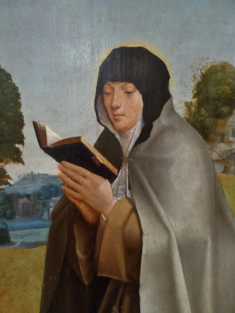St. Colette
| Saint Colette of Corbie, P.C.C. | |
|---|---|

Saint Colette (detail of Saint Clare and Saint Colette, c. 1520, by the Master of Lourinhã; National Museum of Ancient Art, Portugal)
|
|
| Abbess and foundress | |
| Born | Nicole Boellet 13 January 1381 Corbie, County of Amiens, Duchy of Burgundy |
| Died | 6 March 1447 (aged 66) Ghent, County of Flanders, Duchy of Burgundy |
| Venerated in |
Roman Catholicism (Franciscan Order, especially the Colettine Poor Clares) |
| Beatified | 23 January 1740 by Pope Clement XII |
| Canonized | 24 May 1807 by Pope Pius VII |
| Major shrine | Monastery of Bethlehem, Ghent, Belgium |
| Feast | 6 March |
| Patronage | Women seeking to conceive, expectant mothers and sick children |
Colette of Corbie, P.C.C., (13 January 1381 – 6 March 1447) was a French abbess and the foundress of the Colettine Poor Clares, a reform branch of the Order of Saint Clare, better known as the Poor Clares. She is honored as a saint in the Catholic Church. Due to a number of miraculous events claimed during her life, she is venerated as the patron saint of women seeking to conceive, expectant mothers and sick children.
She was born Nicole Boellet (or Boylet) in the village of Corbie, in the Picardy region of France, on 13 January 1381, to Robert Boellet, a poor carpenter at the noted Benedictine Abbey of Corbie, and to his wife, Marguerite Moyon. Her contemporary biographers say that her parents had grown old without having children, before praying to Saint Nicholas for help in having a child. Their prayers were answered when, at the age of 60, Marguerite gave birth to a daughter. Out of gratitude, they named the baby after the saint to whom they credited the miracle of her birth. She was affectionately called Nicolette by her parents, which soon came to be shorted to Colette, by which name she is known.
After her parents died in 1399, Colette joined the Beguines but found their manner of life unchallenging. She received the habit of the Third Order of St. Francis in 1402, and became a hermit under the direction of the Abbot of Corbie, living near the abbey church. After four years of following this ascetic way of life (1402–1406), through several dreams and visions she came to believe that she was being called to reform the Franciscan Second Order, and to return it to its original Franciscan ideals of absolute poverty and austerity.
...
Wikipedia
